Making a Face Mask With a Sock
Why we should all be wearing face masks
(Image credit:
Getty Images
)
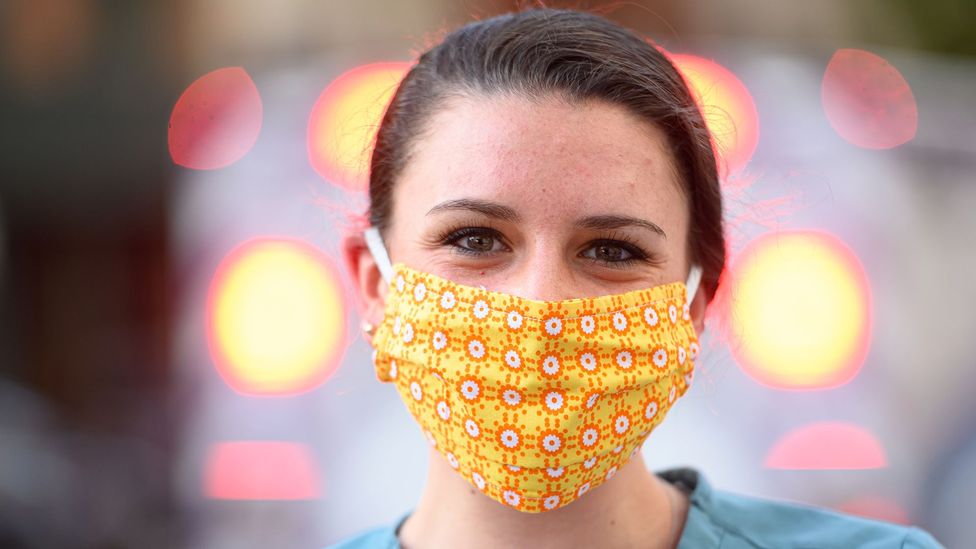
With some countries already emerging from lockdown, can wearing face masks in public help to keep coronavirus infection rates from rising again?
F
Face masks are a symbol of the pandemic era – a visual metaphor for the tiny, unseen viral foe that could be lurking around any corner. Some opt for a scarf wrapped around their face, others make do with a t-shirt yanked up over their mouth. The more creative hook colourful homemade varieties around their ears, while a lucky few wear distinctive surgical masks or, rarer still, N95 respirators.
While a few months ago anyone wearing a mask in public would have drawn stares in many countries unused to this behaviour, they are now a reminder of the strange times we live in. And as governments around the world start to ease their lockdowns to allow their citizens out to mingle in the wider world again, growing numbers of people are opting to wear face masks in public.
But there is still debate about whether members of the public should be encouraged to wear face masks at all, and in some places, such as the US, there have been vocal refusals from prominent individuals over wearing face masks in public. Recent polling has suggested around a third of Americans venture out into public without wearing a mask. A YouGov poll conducted in March suggests that in Spain, Italy and China over 80% of people asked say they wear face coverings. The UK has one of the lowest adoption rates, with just 36% of people saying they wear a mask, but the government there has now announced it will make wearing face masks compulsory in shops from 24 July 2020.
In some countries, such as the US, mask wearing has become an intensely political issue. Some deafness organisations have also warned that widespread facemask wearing may disadvantage people with hearing problems. (Read more about how face masks affect our communication.)
You might also like:
• How long does coronavirus last on surfaces
• Why face shields alone don't protect against Covid-19
• How air pollution makes Covid-19 worse
In the early days of the pandemic, many governments warned the public against wearing face masks for fear demand would leave frontline health workers without vital supplies and that it may lull people into a false sense of security. Some – such as the US – have since reversed that advice. The state of Utah has said it will provide a free face mask to any citizen who requests it. And other countries such as the Czech Republic, Slovakia, Austria, Morocco, Turkey and Germany have all made wearing masks in public mandatory. It is likely others will follow their lead as they ease restrictions.
But can face masks really make a difference in our battle against Covid-19?
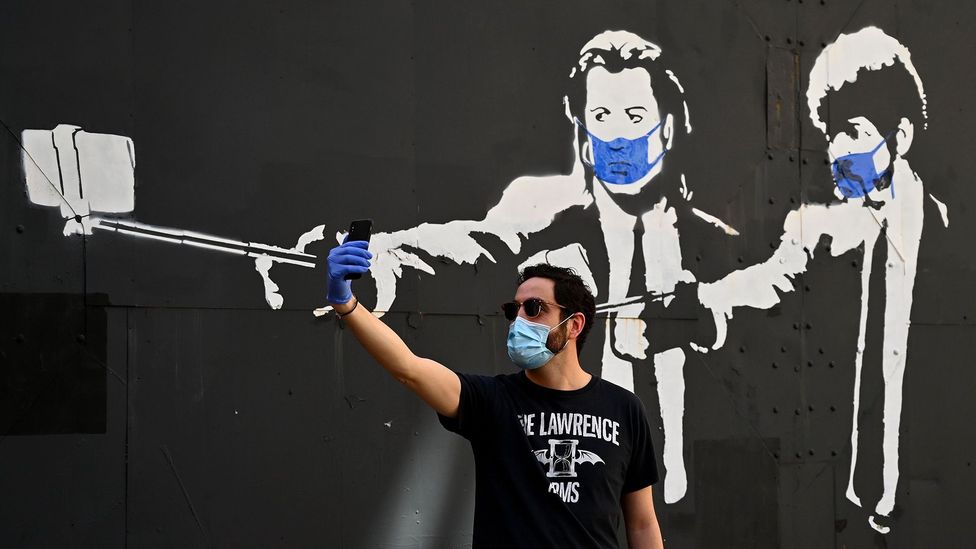
Face masks are likely to become a common part of life when out in public as lockdowns start to be lifted (Credit: Getty Images)
"A key point is that the countries that flattened the curve used masks in public," says Chris Kenyon, head of the sexually transmitted diseases unit at The Institute of Tropical Medicine in Antwerp, who has examined whether face masks may have played a role in limiting the spread of Covid-19 in certain countries. "These were mostly Asian countries. For some reason, until very recently European experts – Czechia (Czech Republic) excluded – were unable to learn from what worked in Asia."
To understand why face masks might work, it is important to look at how the virus that causes Covid-19 spreads in the first place.
Once it has infected someone, the Sars-CoV-2 virus responsible for the disease hijacks their cells to replicate itself. As it multiplies, these new virus particles then burst out of the cells and become suspended in the bodily fluids in our lungs, mouth and nose. When an infected person coughs, they can send showers of tiny droplets – known as aerosols – filled with the virus into the air.
A single cough can produce up to 3,000 droplets. There are fears the virus can also be spread simply through speaking. One recent study showed that we spray thousands of droplets invisible to the naked eye into the air just by uttering the words "stay healthy".
Once out of our mouths, many of the larger droplets will quickly settle onto nearby surfaces while smaller ones remain suspended in the air for hours, where they can be breathed in. While the behaviour of the virus-filled droplets in rooms with air conditioning and outside environments are less well understood, they are thought to settle on surfaces more quickly in disturbed air. There are also some reports that the coronavirus can spread through ventilation systems in buildings. (Read more about how long coronavirus survives on surfaces .)
The Sars-CoV-2 virus has been found to survive in these aerosol droplets for at least three hours, according to one study by virologist Neeltje van Doremalen and her colleagues at the US National Institute of Allergy and Infectious Diseases, Hamilton, Montana. But a more recent, but as yet unpublished study, has found that the Sars-CoV-2 virus is still infectious for more than 16 hours after being suspended in aerosol droplets. It found the virus was "remarkably resilient in aerosol form" compared to other similar coronaviruses they studied.
Together, they suggest that in the right conditions, the virus can linger in the air for several hours and still infect people if breathed in. And in indoor environments, they seem to be particularly prone to spreading through the air.
An unpublished analysis of 318 outbreaks of Covid-19 in China showed that it was most commonly transmitted in indoor environments, particularly in people's homes, but also on public transport, in restaurants, cinemas and shops. They found just one example where the virus appeared to have been transmitted while people were outside. And another recent study found that viable Sars-Cov-2 virus could be isolated from air samples in a hospital in Florida up to 4.8 metres (15.7ft) away from infected patients.
Genetic material from Sars-CoV-2 has also been detected in the air in toilets and rooms used by people infected with Covid-19. One study of a cluster of cases that occured in a restaurant in Guangzhou, China, suggests that in poorly ventilated spaces the virus can spread to people sitting in the immediate vicinity through airborne aerosol droplets.
"Face masks could help to reduce transmission in the community particularly if used in public transport and crowded areas," says Ben Cowling, head of epidemiology and biostatistics at the University of Hong Kong.
He and his colleagues recently published a study looking at the effectiveness of face masks to prevent the spread of the virus from infected people. They found a standard surgical face mask was enough to considerably reduce the amount of virus escaping in the breath and coughs of people infected with different respiratory viruses, including a mild type of coronavirus, influenza and a rhinovirus that causes the common cold.
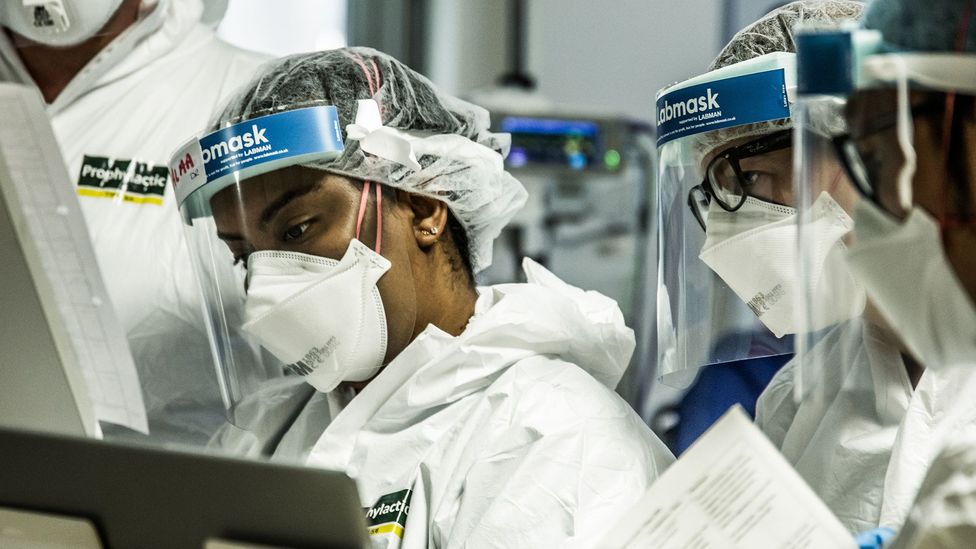
Masks like the N95, FFP2 and FFP3 offer a high level of protection but are prioritised for frontline health workers in some countries (Credit: Matthew Jones/PA)
"One of the proposals for lifting lockdowns is that we use mass testing along with contact tracing and quarantine, to get ahead of infections in the community," says Cowling. "If you are identified as an infected person, the health department can trace your family members, your social contacts and your occupational contacts, but it is very difficult to trace who you were sitting next to on the bus or train.
"If we can limit transmission in these kinds of locations, it could really be a big help."
One of the reasons widespread, public face mask wearing is so important with Covid-19 has to do with the prevalence of asymptomatic carriers who can still spread the virus to others. It is estimated that anywhere from 6% to almost 18% of those infected can carry the virus without developing symptoms. Add to this an incubation period of around five days, but up to 14 days in some cases, before symptoms develop and even those who do go on to show signs of being contagious can spread the virus to a lot of people before they start to fall ill.
"This makes it particularly difficult to suppress transmission in the community," says Cowling. "But if everybody is wearing face masks, that would mean infected and asymptomatic people are also wearing masks. That could help to reduce the amount of virus which gets into the environment and potentially causes infections."
Even wearing a damp homemade mask can reduce the number of droplets each of us emit while we speak, according to a study by researchers at the US National Institutes of Health, Bethesda, Maryland.
So, while face masks might help those already carrying the virus from passing it to others, can they also protect the uninfected from breathing it in?
Certainly the ability of specialised, disposable masks like the N95 respirator and the equivalent FFP-2 respirator mask in Europe to filter out particles from the air is high. They are designed to passively filter out 95% and 94% of airborne particles respectively – down to the size of 0.3 micrometres across – as the wearer breathes. This only applies to those masks that do not have an exhalation valve on the front, which are designed to be more comfortable for prolonged periods by helping the wearer breathe out more easily. Those with valves only offer protection for the wearer and do not prevent infected people wearing one from breathing out the virus into the surroundings. Some health authorities have warned that the valves can even propel germs further, and the CDC does not recommend using masks with valves where the aim is to prevent potentially infected individuals from spreading the virus to others – known as source control.
Their performance when it comes to blocking viruses from entering, however, is also mixed. Some viruses can be as small as 0.01 micrometres, while researchers have reported the coronavirus that causes Covid-19 is 0.07-0.09 micrometres in size. Respiratory viruses, however, tend to be suspended in aerosol droplets, which can range in size from 0.1-900 micrometres, so blocking these is often more important.
Some older studies have suggested that smaller viruses than might be expected can slip through the N95 filter, but they have been found to be effective at blocking the influenza virus.
And there is some research to suggest these respirator masks are effective when it comes to protecting people against Covid-19. One analysis of health workers in China showed that those who wore N95 respirators did not become infected with the virus, despite caring for highly-contagious patients. This is one of the reasons why these masks have been deemed so important for frontline healthcare workers.
The concern is that, if the general public buy up all of the already short supplies of these masks, it will leave these crucial workers, who are the most likely to be exposed, unprotected and vulnerable. The World Health Organization has urged the general public not to wear these masks in order to secure supplies for health workers, and this has also been the rationale behind the reluctance of many governments to encourage the public to wear masks.
There are also some who fear that face masks can induce a false sense of security in those who wear them. One recent unpublished study from researchers at Yale University suggests that in US states where madates have been introduced for face mask wearing in public, people appear to be spending 20-30 minutes less time at home and make more visits to commercial locations such as shops following the change in the rules.
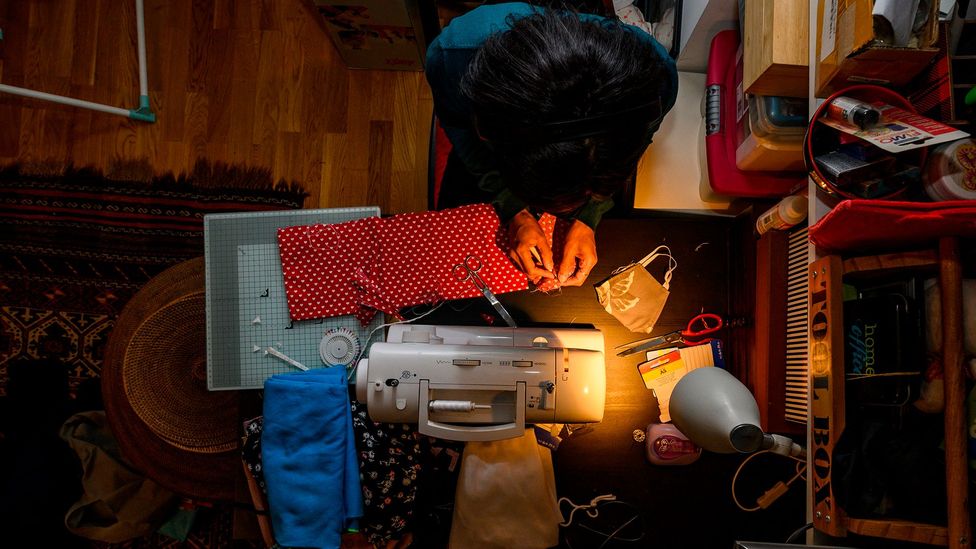
With a shortage of face masks, many people are turning to their sewing machines to make their own (Credit: Getty Images)
While there is now some evidence that respirator masks can be disinfected for reuse, it is far from a perfect solution.
"We really need to ensure we have sufficient supplies of facemasks for healthcare workers," adds Cowling. Such is the shortage of Personal Protective Equipment (PPE) like N95 respirator masks, that some scientists have investigated building alternatives from materials that can be found lying around in hospitals.
Another potential issue with asking the public to wear these masks is that they require training to fit properly. If they are not correctly fitted, the seal around the mouth and nose can still allow viral particles to slip around the side. Facial hair can also affect their performance as it disrupts the seal. The US Centers for Disease Control and Protection (CDC) has published a helpful guide for anyone sporting facial hair and looking to wear face masks – a neat "soul patch", a pencil moustache or Zappa-style trim should be fine. Those sporting designer stubble, a flamboyant Dali or full Garibaldi might need to consider a shave.
But there are simpler alternatives available too. One recent, but yet to be peer-reviewed, study found a 3M surgical mask – the kind worn by surgeons in operating theatres – could keep out almost 75% of particles down to a size of 0.02 micrometres. While far less effective than an N95 respirator, a surgical mask can still help to reduce the number of particles breathed in. But by cutting a hole in the end of a stocking and wearing that over the mask, it was possible to improve the mask's ability to cut out particles to 90%.
"Surgical masks, unlike N95 respirators, are designed to fit loosely," says Loretta Fernandez, an environmental chemist at Northeastern University, in Boston, Massachusetts, who was one of those involved in the study. "This allows some air to go around the mask to the breathing zone rather than through the mask material." They found that the addition of "nylons" on the outside of the mask helped to reduce this.
But with demand for surgical masks also high, many members of the public are being forced to make their own alternatives. There are already a wide range of designs available online for do-it-yourself mask makers, with most using cotton fabric to create a pocket that a filter of some kind can be placed in. Some suggest using vacuum cleaner bags, others add coffee filters between two bandanas or insert folded pillow cases.
Yang Wang, an environmental engineer at Missouri University of Science and Technology, and one of his students built a few examples of these masks and found that using fabrics with a higher thread count worked better. A cotton bandana was the least effective, followed by a woolen scarf, but a 600-thread-count pillowcase folded four times could filter out around 60% of the particles.
Masks made from allergy-reducing air conditioning filters and vacuum cleaner bags were found to work best, almost matching the performance of an N95 respirator.
"There is a lot of potential for fabric masks and particularly masks which incorporate non-woven materials like those used in some dust mops," says Cowling. "There is no reason why surgical masks should be the 'best' type of masks to wear in the community, but some fabrics have too many 'holes' and would not perform well."
Fernandez and her collaborator Amy Mueller, an engineer at Northeastern University, also examined the effectiveness of different homemade masks. The most effective used multiple fabric layers, although they fell some way short of N95 and surgical masks. Adding a nylon on top to clinch the mask onto the face, however, did increase the effectiveness to the point where some homemade designs were able to keep out 80% of the particles.
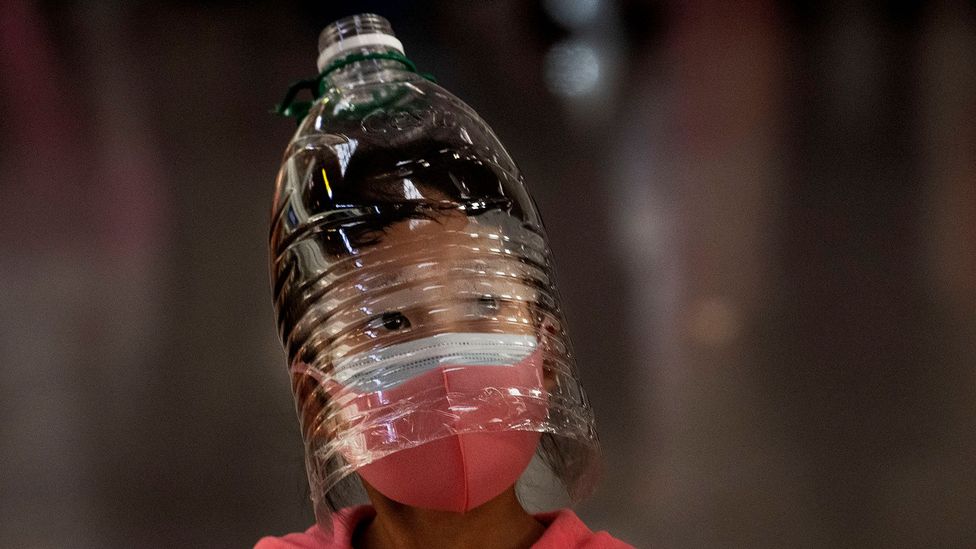
Some homemade masks are more successful than others at protecting the wearer from coronavirus (Credit: Getty Images)
Other researchers have found that while pulling a t-shirt up over your nose and mouth will block less than half of the aerosols coming towards it, doubling and even tripling the layers of a cotton t-shirt fabric can dramatically improve things in an emergency. Other fabrics such as silk and polyester were also found to be surprisingly effective. Cotton flannel, felted wool and quilting cotton have been found to be particularly good at blocking ultrafine particles, and one study suggested that a single sock, when flat and pressed tightly against the nose and mouth, could also serve as a good emergency mask substitute.
Much like the disposable N95 and surgical masks, homemade varieties like these are really only good for one use before they need to be disinfected if you want to maximise their potential. The US CDC recommends routinely washing homemade masks. Hot water alone may not be enough – one recent study found the Sars-CoV-2 virus can survive temperatures of at least 60C. Fortunately, the oily envelope that encases coronaviruses can be pulled part by soap and household detergent.
But Mueller warns that all these alternatives cannot be seen as replacements for an N95 mask. "There is a very important question – for health officials to interpret from the data that we are collecting – about what level of particle filtration is 'safe enough'? It is unfortunate but true that in some cases people may be choosing between multiple imperfect options."
But even with these imperfect options, wearing them in public could make a difference by helping to keep infection rates down as people come out of lockdown and start mingling again. For example, researchers at University College London have warned that the pavements in the UK's busiest city, much like many others around the world, may not be wide enough to allow people to maintain a safe distance from each other. In confined spaces, such as on public transport, it is even harder.
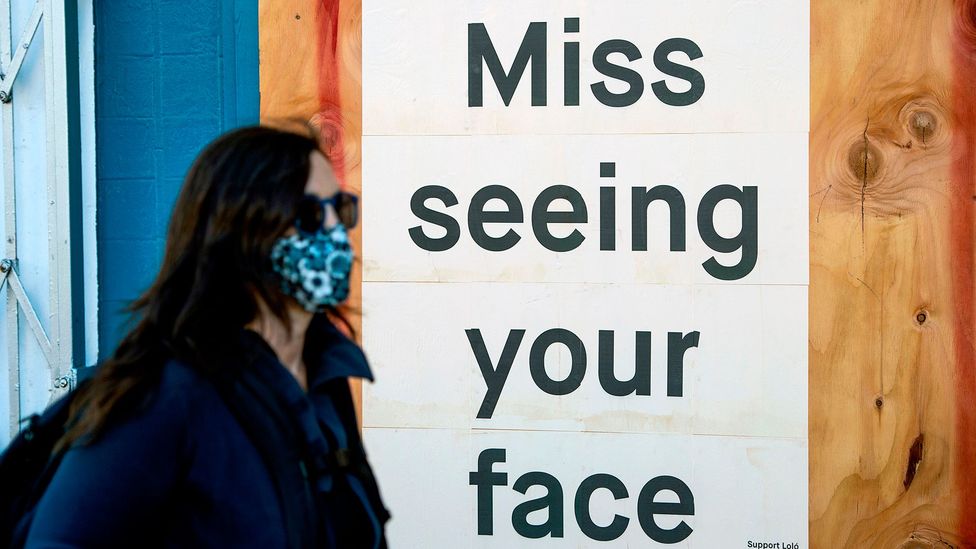
With everyone wearing masks it will become harder to pick up on the subtle communication from facial expressions (Credit: Getty Images)
Tests on homemade masks have shown they can still significantly reduce the spread of other viral infections such as influenza. They can also help to reduce the dispersal of the virus onto nearby surfaces when people cough.
Provided enough people wear masks when venturing out in public, it could have a dramatic impact on how quickly the coronavirus starts to spread again, particularly if combined with other measures such as social distancing and handwashing. One unpublished study by scientists at Arizona State University found that if 80% of people wore only moderately effective masks, it could reduce the number of deaths in New York by 17-45% over a two month period. Even wearing masks that were just 20% effective could cut mortality by 24-65% in Washington and 2-9% in New York, if enough people wore them.
In the days that followed local government decisions in Germany to make wearing face masks in public compulsory, the cumulative number of Covid-19 cases fell by between 2.3% and 13%, depending on how early in the outbreak they were introduced. In the city of Jena, which was the first in the country to mandate for compulsory face mask wearing on 6 April 2020, there was almost a 25% reduction in the cumulative number of reported cases 20 days later compared to models of what may have happened without masks. The researchers estimate that face masks may reduce the growth rate of reported infections by around 40%.
Recent modelling work at the University of Cambridge, which was published in June, also supports these findings. It showed that routine facemask use while in public by 50% or more of the pupulation could bring down the infection rate – also known as the reproduction (R) number – to less than one, helping to flatten the spread of the disease. The more people who adopted masks, and the earlier they were implemented in an outbreak, the better the outcome, even if using homemade masks made from dishcloths or old t-shirts. The study found that an entire population wearing masks that were just 75% effective at keeping out the virus, could reduce the "R" number from a very high level of four, down to less than one without the need for lockdowns.
"We have little to lose from the widespread adoption of facemasks, but the gains could be significant," says Renata Retkute, an epidemiologist at the University of Cambridge, who was one of those involved in the study.
Venki Ramakrishnan, president of the Royal Society, one of the UK's most presitigious scientific bodies, has also added his voice to the debate, urging everyone to wear face coverings when in enclosed pubic spaces. He believes we should now be treating face masks as just "another item of clothing" we would wear when we venture out of our homes.
"If all of us wear one, we protect each other and thereby ourselves, reducing transmission," he says. "We lower the chances of future surges and lockdowns which are economically and psychologically disruptive, and we increase the chance of eliminating the virus."
In countries where masks are in short supply, some researchers have suggested that prioritising them for the elderly could also be effective.
While face masks might bring a little discomfort, and make it harder to spot the facial expressions of those we are talking to, those things are a small price to pay for keeping the people around us safe and well.
* This article was originally published on 5 May 2020. It has since been updated on 27 May 2020 to include research from Yale Univeristy on people's behaviour in US states. A further update was added on 1 July 2020 to include the research on the effect of face masks in Germany and the modelling work by the University of Cambridge. The quote from Venki Ramakrishnan was added on 7 July 2020. An update on the UK governments policy on face masks was added on 14 July 2020. It was updated further on 7 September 2020 to reflect the latest guidance on N95 respirators with exhalation valves.
--
As an award-winning science site, BBC Future is committed to bringing you evidence-based analysis and myth-busting stories around the new coronavirus. You can read more of our Covid-19 coverage here .
--
Join one million Future fans by liking us on Facebook , or follow us on Twitter or Instagram .
If you liked this story, sign up for the weekly bbc.com features newsletter , called "The Essential List". A handpicked selection of stories from BBC Future , Culture , Worklife , and Travel , delivered to your inbox every Friday.
Making a Face Mask With a Sock
Source: https://www.bbc.com/future/article/20200504-coronavirus-what-is-the-best-kind-of-face-mask
0 Response to "Making a Face Mask With a Sock"
Post a Comment